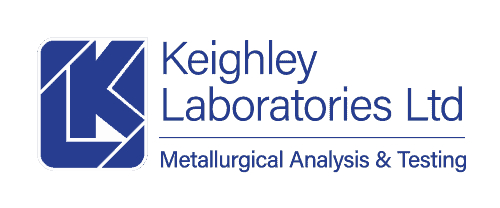Metallographic Examination Optical
Keighley Laboratories carry out accredited Metallographic Examinations to established industry standards to determine the characteristics of metallic materials. Through optical microscopic examinations of the surfaces and core of metals, valuable information can be obtained about the material. These include the grain size, phase verification, segregation, weld assessment, response to heat treatment and surface coating / treatment measurement and verificationProcess
Keighley Laboratories offer industry accredited Optical Metallographic Examinations and services that consist of a multiple-staged process.
A material sample is prepared by sectioning, grinding, polishing and etching. It is then examined by our highly skilled metallurgists under magnification (in either the as-polished or etched condition).
Metallographical examination of the sample allows for determination of certain characteristics of the material. These include the quality of the material, the response to heat treatment or processing, material cleanliness, the grain structure and size and the total case depth measurement.
In addition, examination also allows analysis of casting integrity, alpha case, alloy depletion, deleterious phase check, volume fraction, percentage cavitation, structural evaluation, weld quality and coating/plating thickness measurements.
Benefits of Optical Metallographic Examination
Routine assessments of core and surface structures of metallic materials can check specific features, ensuring that they meet requirements.
It can aid in the assessment of laser cutting, enabling the depth of the re-cast layer to be determined.
Assesses the process of heat treatment regarding the total case depth and case depth quality in steels or furnace integrity and surface contamination in titanium.
It ensures that thread rolling has been carried out correctly, without the production of deleterious defects, such as laps, cracks or shear planes, or even identification of damaged rollers.
It also ensures that materials purchased have the required level of non-metallic inclusions for their intended application.
When heat treating aluminium (sometimes the treatment temperature is close melting point of the material) – examination ensures that this is carried out correctly without resulting in high-temperature oxidation, incipient fusion or eutectic melting.
Coatings applied to materials can be measured, with photographic evidence where required.
The examination can be used as a check for vacuum furnace integrity on titanium alloys (alpha case).
It can be used to support reverse engineering for determining the method of component manufacture.
To aid in establishing the cause of failure during product failure investigations.
Technical Specifications
- Carried out at magnifications from x7 up to x1000, using optical and image analysis capabilities.
- Providing quick and accurate evaluation of microstructure, grain size, cleanliness and volume fraction, nodularity checks and count and deleterious phases.
- Assessment carried out to established standards which may include standard charts and specifications including ASTM E112, ASTM E562, ASTM E45, ASTM A247 etc.
TYPICAL MATERIALS
We perform tests on products, parts and samples made from materials such as:
Ferrous: Iron, Carbon and Alloy Steels, Stainless Steel (including duplex and super duplex steels), Tool and High Alloy Steels, Cast Iron and SG/Ductile Iron etc.
Non-Ferrous: Aluminium and Aluminium Alloys, Copper and Copper Alloys (including Brasses and Bronzes), Titanium, Nickel Alloys, Zinc Alloys, Cobalt Alloys, Tungsten Alloys, Magnesium, Powder Metals and “White Metals” etc.
Matthew Mellor
Technical Services Director
Keith Blower
Technical Director
General Enquiries
Technical Services
Contact Us
Telephone No.+44 (0)1535 664211
